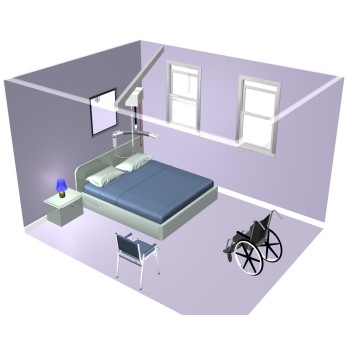Mortuary ceiling track hoist for safer transferring of cadavers

This blog explores the features, benefits, and practical applications of ceiling track hoists in mortuary settings, offering insights into why they are becoming an essential fixture in modern funeral homes, hospitals, and pathology departments.
Request a complimentary survey. via our easy request form.
1. Understanding Ceiling Track Hoists
A ceiling track hoist is a mechanical lifting system mounted to the ceiling, designed to lift and transfer individuals or objects along a fixed track. In mortuaries, these systems are used to move deceased individuals from trolleys to examination tables, refrigeration units, or embalming stations with minimal manual handling.
Key Components:
- Ceiling-mounted track system (straight or XY/gantry)
- Motorized hoist unit
- Lifting sling or body support system
- Remote control or wall-mounted control panel
2. Why Mortuaries Need Ceiling Track Hoists
Mortuary work involves repetitive lifting, transferring, and positioning of cadavers—tasks that are physically demanding and potentially hazardous. Traditional manual handling methods expose staff to musculoskeletal injuries, fatigue, and emotional strain. Ceiling track hoists address these challenges by:
- Reducing physical strain
- Improving workflow efficiency
- Enhancing dignity in body handling
- Complying with health and safety regulations
3. Core Features of Ceiling Track Hoists in Mortuaries
- Fixed Ceiling Installation: Frees up valuable floor space and ensures unobstructed movement.
- XY (Gantry) Track Systems: Allows full room coverage with movement in both horizontal directions.
- Motorized Lifting Mechanism: Smooth, controlled lifting with variable speed settings.
- Emergency Stop and Safety Features: Includes emergency stop buttons, overload protection, and battery backup.
- Hygienic and Easy-to-Clean Design: Made from stainless steel or powder-coated aluminum for easy cleaning and corrosion resistance.
4. Benefits of Ceiling Track Hoists in Mortuary Environments
- Enhanced Staff Safety: Reduces the risk of back injuries and accidents.
- Improved Dignity and Respect: Enables smooth, discreet transfers that preserve the dignity of the deceased.
- Operational Efficiency: Enables single-person operation, reducing staffing needs.
- Space Optimization: Eliminates the need for mobile hoists, freeing up floor space.
- Compliance with Health and Safety Standards: Meets regulations for manual handling and infection control.
5. Applications in Mortuary Workflows
- Body Reception and Transfer: Transfers from stretcher to refrigeration or examination table.
- Post-Mortem Examination: Repositions the body for better access during autopsies.
- Embalming and Preparation: Assists in transferring bodies to embalming tables.
- Refrigeration and Storage: Lifts bodies into storage units with precision.
6. Comparing Ceiling Hoists to Mobile Hoists
| Feature | Ceiling Track Hoist | Mobile Hoist |
|---|---|---|
| Space Efficiency | High – no floor footprint | Low – occupies floor space |
| Ease of Use | Very easy, single-operator | Requires maneuvering, often two operators |
| Safety | High–stable and controlled | Moderate – risk of tipping or obstruction |
| Maintenance | Low–fixed system, fewer moving parts | Higher batteries, wheels, and joints |
| Cost Efficiency | Higher upfront, lower long-term | Lower upfront, higher long-term labor costs |
7. Considerations for Installation
- Structural Assessment: Ensure the ceiling can support the system.
- Track Layout: Design to cover all key workstations.
- Power Supply: Ensure reliable power with battery backup.
- Training and Certification: Train staff in safe operation and maintenance.
8. Real-World Case Study: A Mortuary Transformation
A mid-sized hospital in the UK installed a ceiling track hoist system in its mortuary. Results included:
- 40% reduction in manual handling incidents
- Faster turnaround times for post-mortem procedures
- Improved staff morale and job satisfaction
- Positive feedback from families and funeral directors
9. Maintenance and Longevity
- Monthly inspections of tracks and hoist mechanisms
- Annual servicing by certified technicians
- Routine cleaning to maintain hygiene
- Self-diagnostic features and usage logs for scheduling
10. Future Innovations
- Smart hoists with digital load monitoring
- Voice-activated controls
- Integration with mortuary management software
- Automated tracking of usage and maintenance
Conclusion
Ceiling track hoists are more than just lifting devices—they are essential tools that uphold the values of dignity, safety, and efficiency in mortuary care. By investing in this technology, mortuaries can protect their staff, honor the deceased, and streamline their operations in a way that meets the highest professional standards.
Whether you're managing a hospital mortuary, a private funeral home, or a forensic pathology lab, a ceiling track hoist is a smart, respectful, and forward-thinking solution.


